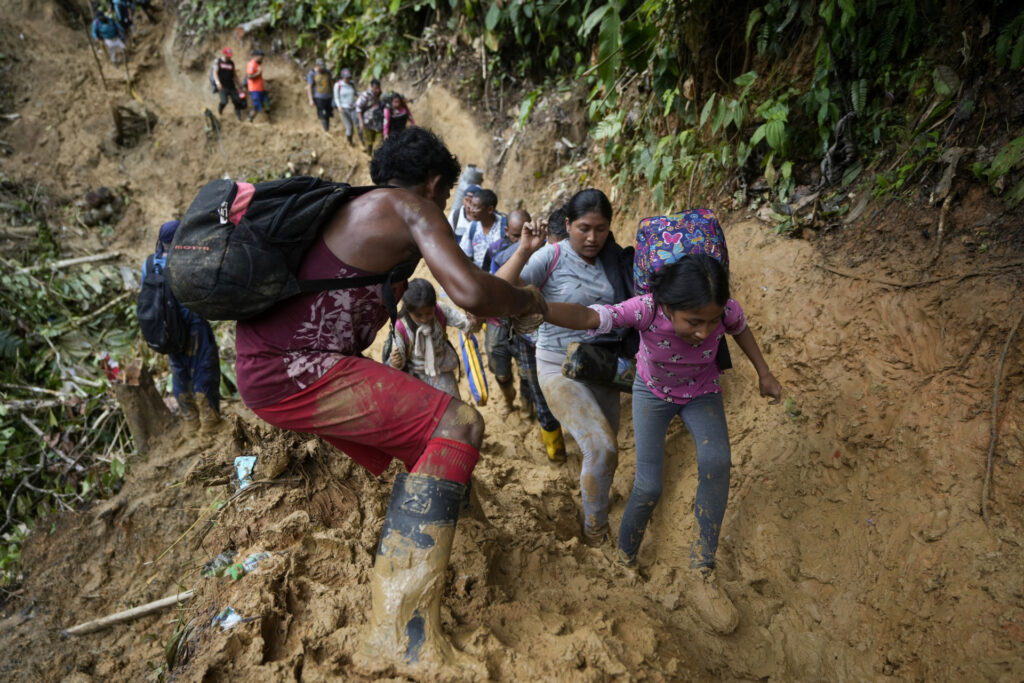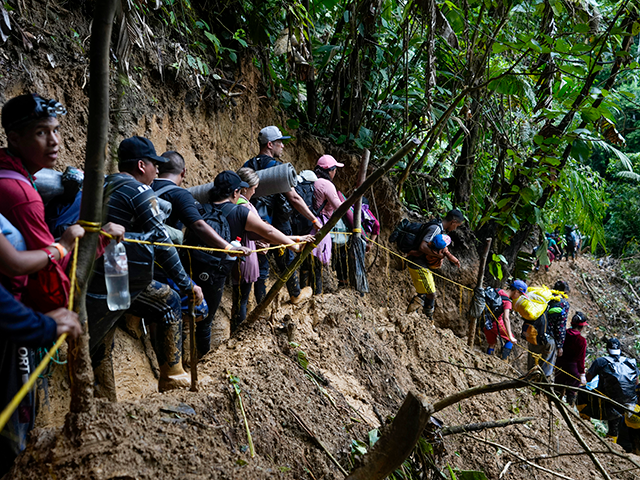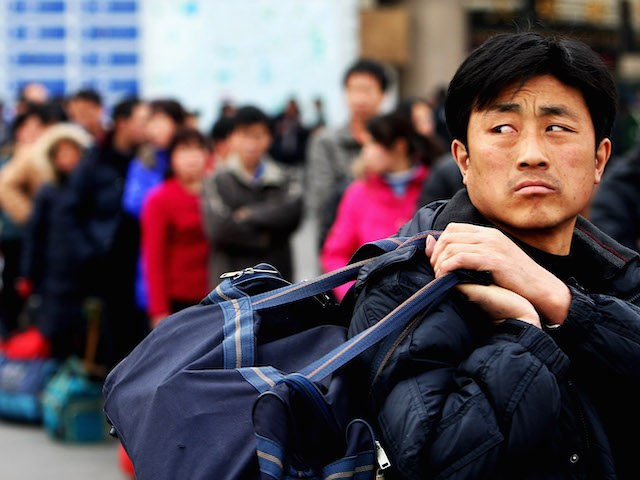China’s economic migrants are joining the global rush into America as President Joe Biden’s deputies widen legal loopholes in the southern border, according to a U.S.-funded news agency.
The route for China’s migrants goes through Ecuador in South America. Then the migrants take buses, taxis, and boats to reach the deadly Darien Gap jungle trail in Panama, where the United Nations helps them travel further north towards Costa Rica, Mexico, and the United States, according to a December 26 article by Radio Free Asia.

Migrants, mostly Venezuelans, walk across the Darien Gap from Colombia into Panama hoping to reach the U.S. on Saturday, October 15, 2022. (AP Photo/Fernando Vergara)
The article said:
1,028 Chinese citizens entered Colombia from Ecuador through unofficial channels between January and November 2022, 458 of whom did so in November alone.
Nearly all of them pass through Necoclí, the jumping-off point for the notorious Darién Gap people-smuggling route through the jungle from Panama to Colombia, in a bid to cross eventually into the United States.
According to two shipping companies that ship travelers to the trailhead in Panama, 122 Chinese people have bought tickets during the past week.

A group of migrants, mostly Venezuelans, walk across the Darien Gap from Colombia into Panama hoping to reach the U.S. on Saturday, October 15, 2022. (AP Photo/Fernando Vergara)
A pipeline of 122 people per week adds up to 6,300 a year — if the flow somehow stops growing.
The arrival of more Chinese reflects the growing global awareness that Biden is dangling the hope of U.S. jobs, homes, and lives to ambitious young people everywhere — whatever the huge economic and civic damage to ordinary Americans.
For example, the number of Indian migrants detained at the border rose from 20,000 in 2020 up to 64,000 in 2022. The Filipino inflow rose from 46,000 in 2019 up to 55,000 in 2022. In 2022, Biden’s border officials admitted 114,000 people from those two countries, regardless of the Title 42 barrier or section 212(f) in federal laws that allow the president to exclude any alien.
By subscribing, you agree to our terms of use & privacy policy. You will receive email marketing messages from Breitbart News Network to the email you provide. You may unsubscribe at any time.
But Biden’s invite is also drawing more migrants from every corner of the world as poor people scramble to grab their slice of America before U.S. citizens can restore their borders with a new President. “The 2.4 million Border Patrol encounters with migrants in the 2022 fiscal year that ended on Sept. 30 represented a record high,” the New York Times reported on December 29:
There was a nearly 2000 percent increase in the number of Colombians encountered during that period compared with the previous fiscal year; Indians increased by 607 percent; Cubans by 471 percent; Russians by 430 percent and Nicaraguans by 227 percent.
Overall, Biden accepted almost as many illegal, legal, and temporary migrants as there were U.S. births in 2022 — and he has deported fewer than 100,000 migrants.
The growing U.S. populations of legal migrants and of temporary visa workers — such as Indian H-1B visa workers — are also pulling in more illegal migrants for lower-skill jobs in ethnic districts.
The Chinese migrants are guided along their routes, and around legal obstacles, by maps posted online by prior migrants and American pro-migration groups.
There is no road between South America and Central America, so the global migrants must take a boat from Columbia, and then use boats and jungle trails to reach buses in rural Panama. The route is a shorter and safer version of the earlier Darien Gap trail — where thousands of migrants likely died in 2021 and 2022. The shorter trail was created by Biden’s zealously pro-migration border chief, Alejandro Mayorkas.
The myriad migrants from all over the world are aided by rest stations that are funded by industry by U.S. taxpayers. For example, migrants are helped by a United Nations aid station in the Columbian port of Necoclí:
Near the jetty where the travelers will embark, the United Nations’ International Organization for Migration has set up a tent, while the local government has its own tent facing it. A third canopy provides shade to people waiting to board the next vessel to Panama, who hail from Afghanistan, India, Latin America, the Caribbean, and, more recently, from China.
U.S. officials are trying to gain control of the travel routes.
Mayorkas’ goal is not to stop migration, but to sideline the cartels so international progressive groups can take over the lucrative business of recruiting and moving migrants into Americans’ jobs and housing.
The progressive-run network is helping the alliance of businesses and progressives because it reduces the risk of political embarrassments which might cause a public backlash against the migration policies that transfer wealth and power from ordinary Americans to the coastal investor class. Those embarrassments would include unwanted media descriptions of migrant deaths, or the televised arrival of too many migrants at the U.S. border.
For example, Mayorkas visited Ecuador in December, likely to demand more control of the country’s easy visa rules.
Mayorkas also visited Colombia to talk about migration with the country’s new left-wing president. Mayorkas tweeted:
I appreciated meeting with President @petrogustavo this morning at his invitation to build on the momentum created at the Summit of the Americas. Transnational crime and irregular migration are challenges not exclusive to the U.S. or Colombia. They demand a hemispheric solution.
“There’s a policy called ‘Controlled Flow‘ and it’s been in place for years,” said Todd Bensman, a security and migration expert at the Center for Immigration Studies. “The Panamanians, the Colombians, Costa Ricans, have all abided by this thing for years … They just altered it a little bit [in early 2022] so that the flow goes around the Darien Gap and not through it anymore,” he told Breitbart News in November.
Mayorkas has met with many foreign governments to smooth the migration process into Americans’ jobs and homes. For example, in Colombia, Mayorkas tweeted his support for migration and easy asylum rules:
In bilateral meetings alongside Chargé Palmieri @USEmbassyBogota, we expressed to the Gov of Colombia our commitment to continuing to respect the dignity of migrants, while reiterating the importance that the laws of our respective countries are followed.
Colombian officials turn a blind eye to the Chinese illegal migrants, the RFA.org article reported:
“The current attitude of the Colombian government is to respect the freedom of movement of immigrants,” the official says on condition of anonymity. “From a practical point of view, it is really too expensive to send them back.”
Similarly, Mayorkas worked with Panama to help economic migrants get through the deadly Darien Gap.
Breitbart News reported in August 2021, “‘By consensus, the humanitarian approach will guide the actions that we agree on for the orderly and controlled passage of migrants on their way north,’ Panama’s Minister of Foreign Affairs, Erika Moynes, declared during the teleconference.”
Many migrants die — especially in the Darien Gap trail — because of the U.S. policy of extracting young people from poor countries for use in the U.S. service economy.
The huge scale of the migration, and the many deaths, get minimal publicity from American media outlets, which portrays migration as an international civil rights issue, not as a U.S. economic policy.
Economic migrants recognize this progressive perspective and mix in claims of persecution with their demands to be allowed to get U.S. jobs. For example, some of the migrants bring young children to get through the Flores loophole.
RFA.org interviewed a Chinese migrant who was released into the United States with his wife and family — and who is now unlikely to be sent home:
The family flew to Bangkok, then Istanbul, where they spent six months, then took a flight to Quito, where they boarded a long-distance bus to Tulcan on the border with Colombia. They rented a car from there, and drove it to Necoclí, before boarding a boat to the Panamanian jungle route via the Gap of Darién.
…
the family flew to Bangkok, then Istanbul, where they spent six months, then took a flight to Quito, where they boarded a long-distance bus to Tulcan on the border with Colombia. They rented a car from there, and drove it to Necoclí, before boarding a boat to the Panamanian jungle route via the Gap of Darién.
When they reached the United States, “Cheng’s family was released after just one night in detention because they had a young child with them.”
Few Chinese migrants are sent home, partly because China’s government refuses to accept even their own migrants who have committed crimes against Americans. In response, U.S. officials do nothing for fear of disrupting U.S. business deals in China.
Since 1980, China has grown its economy by investing in Chinese manufacturing and workers.
In contrast, since 1990, the U.S. government has operated an economic policy of “Extraction Migration” which pulls human resources from poor countries and uses the imported consumers, renters, and workers to grow the service economy and investors‘ stock values.
The migrant inflow has successfully forced down Americans’ wages, boosted rents and housing prices, and shriveled coastal investors’ interest in heartland towns. The inflow has also pushed many native-born Americans out of careers in a wide variety of business sectors.
It has also reduced native-born Americans’ clout in local and national elections, so helping the coastal elites to regain power after the shocking electoral success of Donald Trump’s 2016 lower-migration, higher-wage promises.

COMMENTS
Please let us know if you're having issues with commenting.